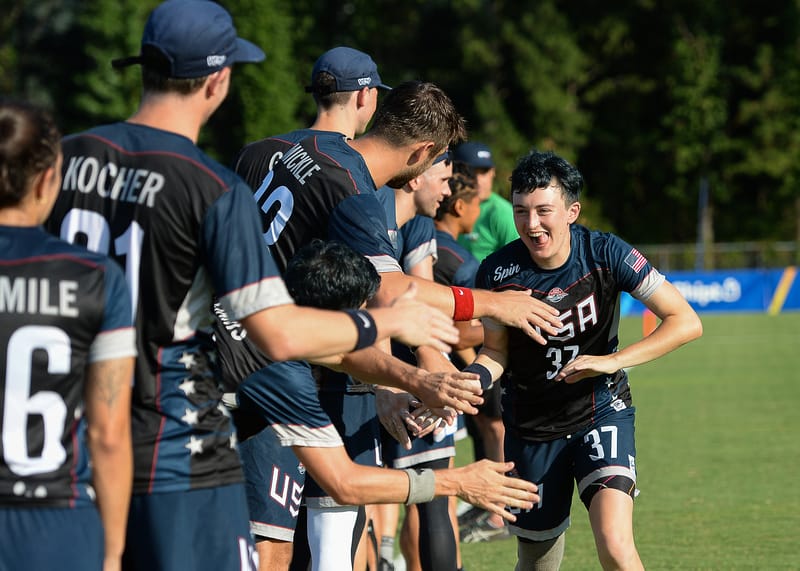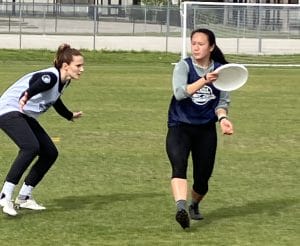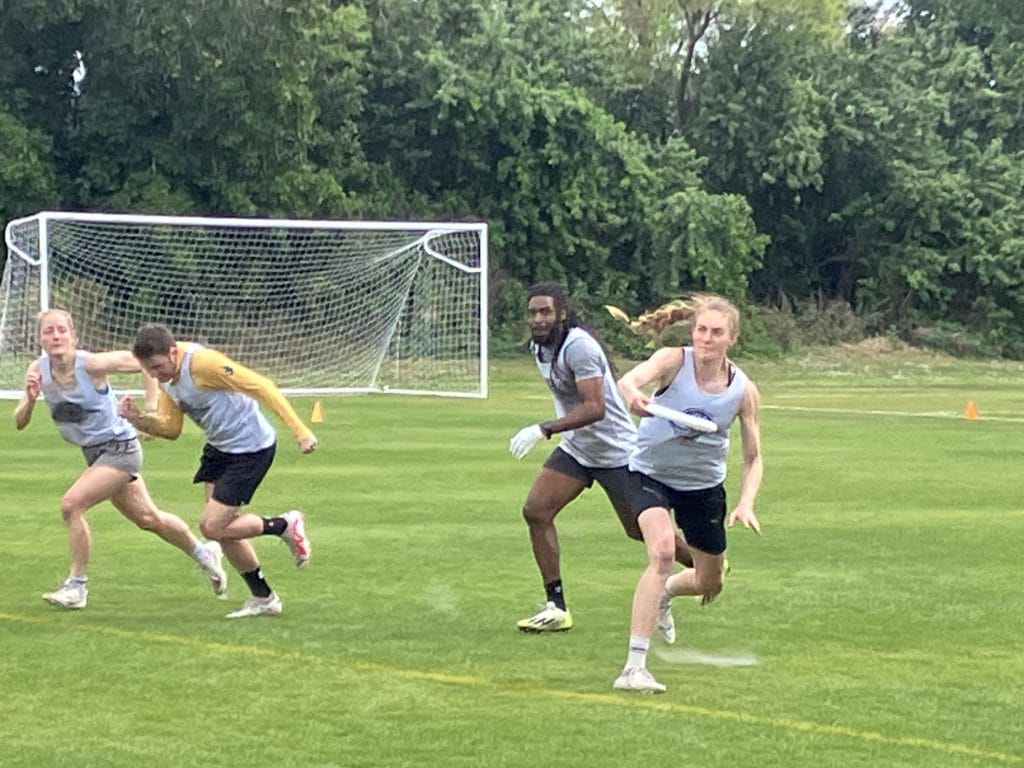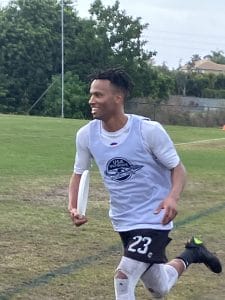Edward Stephens takes on the unenviable role of selecting Team USA based on East Coast Tryouts. Presenting: the Locks, the Likelies, and the Great Plains-sized Bubble.
March 11, 2024 by Edward Stephens in Recap with 0 comments

I don’t envy the Team USA coaching staff and selection advisors. Simply put: the math sucks. Ninety-six players attended East Coast tryouts, 48 each of men’s matching and women’s matching (by my unofficial but painstaking spreadsheet count), vying for 72 spots on one of the three teams traveling to Australia for WUC later this year. It would be a bad gig to pare down the list even without taking into account the roughly equal number of players who attended West Coast tryouts the weekend before. They’re going to have to make absurd choices from a bounty of riches. When they’ve finished with that, they’re going to have to deliver disappointing news to a huge number of talented players. That isn’t anyone’s idea of a good time.
In the spirit of commiseration, then, I’ll try my hand at being a committee-of-one, shaking out the keepers and discarding… well, more keepers. I have kicked tires, split hairs, made a few Sophie’s choices, and come up with what I expect will be the Locks, the Likelies, and the Great Plains-sized Bubble.
Some Ground Rules: As much as possible, I tried to judge the players solely by what I saw on the field of play at the tryout. It’s impossible to banish preconceived notions of talent and roles entirely, of course, but I did my best. I also considered roles on the field and tiers of play within those roles – this isn’t the World Games where every player needs to be capable of doing everything.
A Big Caveat: There were always three (and sometimes four) fields of action going on at once. That means I only ever saw, at most, 40% of the play at any given moment. I watched a lot of frisbee, but I missed even more. So to those of you reading this who were there and think I’m dead-wrong about someone… you’re probably right.

Locks
- Kami Groom
- Rowan McDonnell
- Sarah Meckstroth
- Eric Taylor
- Claire Trop
- Angela Zhu
These are the players who are going form the backbone of the three US squads. Orient the map around these landmarks. Some of them are no surprise at all. At the tryout Claire Trop, Sarah Meckstroth, and Kami Groom were everything they have proved to be for years: ace cutters and ace cutter defenders. Especially if they end up on the same roster, they’ll form the biggest advantage the US has over any of its opponents in Gold Coast. Angela Zhu also played herself into lock status (after some admittedly clunky throwing to start on Saturday morning), hitting full speed by being a block-getting reset defender and offensive linchpin after turnovers during the scrimmages.
McDonnell and Eric Taylor were, in my eyes, far more unlikely shoe-ins before I saw them play (although if you were picking names without a tryout both would have been candidates). The touch on Taylor’s throws in every condition, short or long (including pulls), was unmatched. And McDonnell was simply the best all-around offensive player at the tryout. Look for their names on the roster announcements.
Gobsmackers
- Alex Barnett
- Christian Boxley
- Dawn Culton
- Anders Juengst
- Lindsay Soo
There’s plenty of Triangle love in the subsection I’m calling “Gobsmackers.” As in, I’d be gobsmacked if they didn’t make a team. Juengst continues to push both the polish and the power of his game beyond what I had thought of as his ceiling – this must be the fourth or fifth consecutive vehicle for showcasing his talents where he’s played even better than the one prior. He was already trending that way before, but in his last chance in front of the mixed coaches on Sunday, he played eight counts of perfect reset defense twice in the span of three throws. That tied the bow on his weekend. He’ll get the call. Boxley was (for the most part) the kind of player he was in 2023 club play: smooth, fast, considered, assertive. As a bonus, even in a tryout full of positive energy he was one of the more visibly affable teammates on the field.
Dawn Culton, somewhat surprisingly, makes her appearance in this set on the strength of her offense. She was quick to show off the well-rounded side of her game, hitting 50-yd hucks easily from both sides to complement her famous defensive intensity (which was also on display). Alex Barnett is a plug-and-play QB1 for either the women’s or mixed teams. The chemistry she formed with anyone in a backfield with her was almost instantaneous. She was creative and incisive in the best ways, and she kept mistakes to an absolute minimum.
My wildest call here is Lindsay Soo, whose tryout ended early on Sunday when they left the field with an injury. It didn’t matter. In the play that came before the injury, Soo stood out for their power in the cutting lanes, their magnetic hands, technical and physical defense, and a nose for time and space that meant being open was a constant. They stacked up well against a direct comparison in Meckstroth. What more do you want?
The Likelies
- Erica Baken
- Genny De Jesus
- Abby Hecko
- Brett Hulsmeyer
- Chris Kocher
- Jonny Malks
- Becky Malinowski
- Lindsay McKenna
- Tyler Monroe
- Raha Mozaffari
- Jessie O’Connor
- John Randolph
- Caroline Tornquist
- Cam Wariner
The segments are growing. They can afford to because, frankly, I don’t see the cases as clearly. Some of these players are going to get cut – at the end of the day, it’s musical chairs. That said, if I were in charge of picking the teams I would take all of them. In any case, I like their chances at an offer. Call them betting favorites.
Malinowski and De Jesus run the risk of being too much like Soo and Meckstroth without quite as many highlights as either. But they were both tremendous, and I can’t think of a team anywhere that doesn’t need at least four brilliant lane cutters. O’Connor, Baken, Mizener, and (suprisingly, to me) Hecko slotted right behind Barnett as the most effective women’s-matching handlers – O’Connor for sheer skill, Baken for leadership, Mizener for an attack-always mentality, and Hecko for metronomic steadiness.
AMP teammates Mozaffari and McKenna lead the charge for hybrids. Both showed off a wide range of skills, transitioning easily between being ball-dominant throwers and skillful receivers. McKenna also brings a special skill to the mix: infectious joy. She kept everyone’s spirits high throughout the weekend. In this reporter’s opinion, that’s an essential ingredient for a long week far from home. Tornquist is the epitome of the no-weaknesses mold of player.
Kocher and Malks largely replicated their club play. Monroe and Randolph did the same, only it was clear that each of them wanted to take center stage for big plays a bit more often than is typical for them. The real revelations here on the men’s matching side were from Hulsmeyer and Wariner. Hulsmeyer outplayed the other bigs, particularly on defense, including a few staggering clean blocks late on Sunday in mixed. Wariner’s case is that he can jump higher and lay out farther and run faster (at least, in 10-yard bursts) than any of his peers. If this had been an NFL combine, he would be the player pinning the scouts’ eyebrows to their hairlines.
Head-Turners: Getting a Long Look
- Hayden Austin-Knab

Alexandre Fall at the Team USA 2024 East Coast Tryouts. Photo: Edward Stephens - Abby Cheng
- Thomas Edmonds
- Alexandre Fall
- Olivia Hampton
- Matt Gouchoe-Hanas
- Troy Holland
- Rena Kawabata
- Jolie Krebs
- Jeremy Langdon
- Jibran Mieser
- Terrence Mitchell
- Emma Peaslee
- Erynn Schroeder
- Liam Searles-Bohs
- Tyler Smith
- Jasper Tom
- Sol Yanuck
With this group we get into a segment I feel much iffier about. They turned heads at the tryout and bring a lot to the table without being absolute slam-dunk picks. Based on the numbers, I’d wager a little over half of them get the nod. Say, 10 out of the 18 above? Which is tough, because it means that several players who cleared the bar with ease in theory aren’t going to clear it in practice.
They range from players who clearly wanted to put their best defensive foot forward in front of the coaches (Peaslee, Tom) to nimble defenders who took pains to show off their offensive prowess (Mieser, Holland) to steady-in-the-face-of pressure offensive cogs (Mitchell, Hampton, Gouchoe-Hanas) to players who wanted to shape the field with their creative away throws (Smith, Kawabata).
Jeremy Langdon was an interesting case. He was effective while playing a notably different style than the rest of the field. He wanted different attack angles on offense (and had to communicate with teammates frequently to make them a reality) and played a style of defense that seemingly relied on positioning and quick arm reaction more than textbook footwork and pure speed. Another was Terrence Mitchell, who operated in the backfield far more than I’ve seen from him in the past and looked enormously comfortable there, especially on the mixed field.
Erynn Schroeder seems to have mostly ditched the high-flying power-cutting of their younger days in favor of a more measured role as a handler: the natural power of their throws was channeled into high-spin, precision unders. Olivia Hampton brought a somewhat standard high-level mix of skills to the table and added considerable grit and moxie. Tangling with Mozaffari for a couple of points on the mixed field, she demonstrated the kind of resolve and motor necessary to win out a grueling point – and she did eventually win out in those moments. Hayden Austin-Knab’s break throws were some of the touchiest at every release angle. It’s clearly a part of his game that he’s been grooming and makes a smart complement to his redline effort as a cutter and defender.
If I’m picking – me, personally, not as a prediction for who the coaches will tap – just a handful of these to make it through, though, give me: Krebs, Tom, Fall, and Cheng. I’m a sucker for (in no particular order) visible effort, speed, teamwork, and aggressive offense. Jasper Tom, Alexandre Fall, and Abby Cheng all check the elite footspeed box. Cheng, in particular, was jaw-droppingly fast. She was as relentless on offense in the lanes as Tom was as a reset defender. With Fall on the team you also get one of the most uplifting personalities in attendance, both with his spirit-raising defensive bids and his outspokenly positive sideline presence. (In the latter category, he is on par with Eric Taylor and Lindsay McKenna, see above.)
And – Krebs. What a revelation. The XIST (and college) star put together the best possible tryout: she was probably a top-10 player on the first day of East Coast tryouts. She went through progressions at a furious clip with brand-new teammates immediately, making difficult decisions without batting an eye and executing tricky split-second throws to make them stand up. More importantly, she attacked constantly, refusing to settle for passes and cuts that wouldn’t give her offense an advantage. Is she technically one of the 36 best WMPs trying out for Team USA? I’m not sure. But I am certain that showing that kind of mentality at a tryout of this caliber at her age is a sign of greatness to come – soon. I’ll take the over on Krebs hitting the upper limits of her potential by September
Potential Role Fillers

The last category worth highlighting are the players who played well without necessarily being generally dominant or absolutely eyepopping. All have a case to make the team, but a lower percentage of them will. At this stage, I would guess coaches will lean a bit more into team construction to plug gaps with various superpowers. Not knowing what they’ll need on the teams, it’s impossible to know who they’ll take. Instead, here’s a rundown of what advantages they’d gain by taking each of the players below.
- Josue Alorro – Puller, handler defender, fast-paced handling
- Peter Boerth1 – Elite cut timing and finishing – better in the lanes than in the goal box
- Simon Carapella – Elite cut timing and finishing – better in the goal box than the lanes
- Dylan DeClerck – Two massive defensive bids per game, lots of energy
- Ned Dick – Annoyingly effective break throws, effort
- Tulsa Douglas – Height in the handler space, precise inside breaks, sure hands
- Jamie Eriksson – Pulls, unnervingly steady swing throws, ability to reach over a pile
- Harper Garvey – Nose for weak points as a cutter, game-changing hammers and forehands
- Nate Goff – Extreme versatility to go along with height
- Ben Jagt – Tremendous understanding of role and space to go along with height
- Ella Juengst – Always open and great hands, even under pressure
- Sean Keegan – Surprising flatline speed, attack mentality, break throws
- Audrey Lyman – A deep backhand that just won’t quit, great sit even in the wind
- Linda Morse – Ruthless finisher on offense
- Sean Mott – The perfect connective node from the handler set to breakside cutters
- Amanda Murphy – Conventional outstanding matchup defense, unconventional effective offense
- Jonathan Nethercutt – Handler defense, throwing versatility
- Luisa Neves – Rocksteady handling under pressure
- Mary Rippe – Defensive bulldog, top 25% footspeed at tryout
- Blaise Sevier – Bids. Offensive or defensive.
- Qxhna Titcomb – Step-out throwing to move marks and clear on-field leadership
Boerth was injured on Saturday and did not play Sunday – that may take him out of serious consideration ↩
